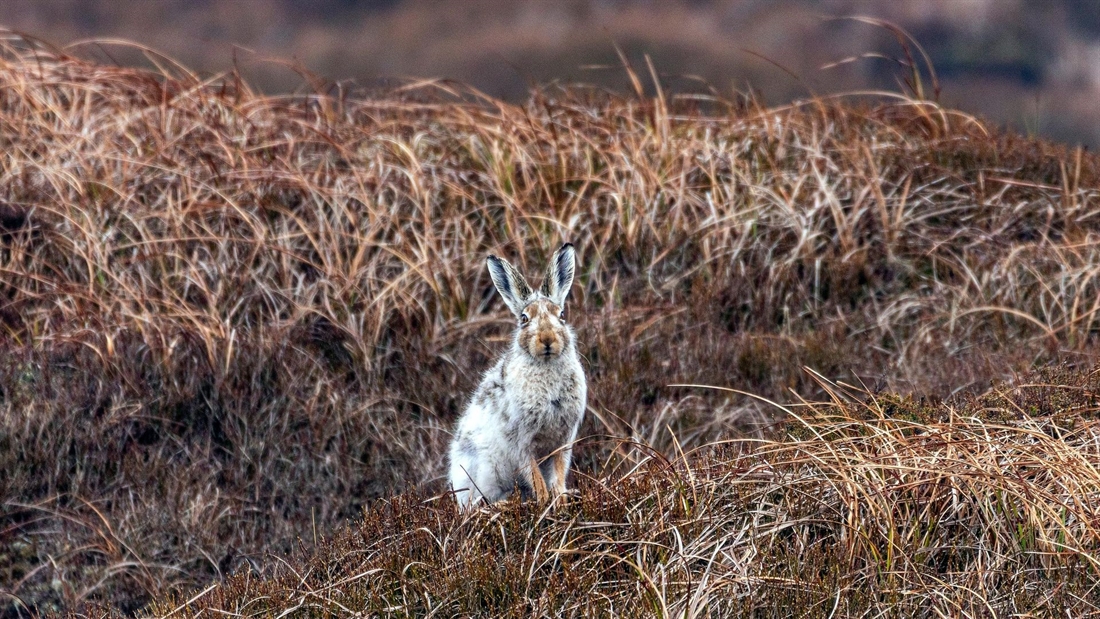Shining a light on mountain hares

Despite news reports to the contrary, James Swyer reveals that research carried out by the GWCT shows how mountain hare populations are thriving in the Peak District
Rigorous counting from gamekeepers has given hope to the Peak District’s population of mountain hares, showing their numbers are much better than feared. Last year, a BBC headline claimed that the Peak District’s last surviving mountain hares were ‘at risk’, following reports by the People’s Trust for Endangered Species (PTES), drawing on a paper by Manchester Metropolitan University (MMU).
The new study showed that mountain hare densities in the Peak District could be five times higher than previous estimates. Counting was undertaken at night using specialised equipment instead of the less reliable method of undertaking daytime transects. The new methodology has been used to great effect in Scotland, and its use on the Peak District population is a first.
The monitoring was undertaken by the Peak District Moorland Group, whose members have reported regular mountain hare sightings across 16 estates covering 240km2 within the Dark Peak area of the national park. We’re delighted by how much coverage the efforts of these gamekeepers has received, with articles in the Telegraph, Daily Mail, on BBC Radio Four and elsewhere.
So, what’s changed? Interested in understanding the true population status of mountain hares, gamekeepers worked with the Peak District Moorland Group (PDMG), Moorland Association (MA), National Gamekeepers Organisation (NGO), BASC and the GWCT to get a real picture of mountain hares in the area.
In 2021, the GWCT trained a number of Peak District gamekeepers to count mountain hares at night using the methodology that the GWCT have pioneered in Scotland. The counts were analysed and compared to results from north of the border. The study indicates that the number of hares being recorded by gamekeepers in the Peak District may be equivalent to a population density of between 52 and 126 mountain hares per km2. The population levels are similar to those recently recorded within the mountain hare’s core range in Scotland, and are up to five times higher than the most recent estimates of mountain hare densities at other sites in the Peak District National Park.
However, there are two main differences between the two studies. Firstly, the Manchester Metropolitan University study, as quoted by the PTES, looked predominantly at unkeepered sites. Our work in Scotland has shown that mountain hares are more abundant on driven grouse moors where they benefit from grouse management. The MMU study also relied on daytime counts and the deployment of remote cameras, but overlooked the use of night-time counts of this crepuscular creature, despite its activity peaking at dawn and dusk.
GWCT scientist Dr Nick Hesford is the lead author on the forthcoming paper. He said: “The threats of traffic accidents, isolated populations, disease and climate change remain, but this survey is welcome news for the species. Although we only have data from one year of surveys so far, the adoption of this new methodology in the Peak District is a breakthrough for the population, and it is our hope this survey continues to help conservation efforts in the future.”
Learning from GWCT efforts in Scotland
We have been here before. In 2018, a paper published in the Journal of Applied Ecology prompted sensational headlines suggesting that the mountain hare population in Scotland was at 1% of its 1950s level. As with the story in the Peak District, the issue comes from the fact that the paper was based on daytime counting, which was not consistent, employing dogs on some occasions but relying on visual observations only at others.
The GWCT’s Dr Kathy Fletcher worked with Dr Scott Newey from the James Hutton Institute and Rob Raynor of NatureScot to produce a report which identified night-time counting as a simple and robust approach, observing that standard daytime counts detect a fraction of night-time numbers. This has proven to be the case once more in the Peak District.
How do counts work?
Night-time counting is the approved way to count mountain hares. The GWCT trains land managers to use widely available lamping equipment for counting. Mountain hare numbers are recorded on four fixed transects, each two kilometres long, within a survey area. Completed count cards or the Epicollect Mobile app can be used to report a count to the GWCT.
In Scotland, the GWCT has rolled out night-time counting and has now trained more than 130 people from 70 estates. These counts clearly demonstrated robust numbers of mountain hares in key areas managed for grouse. We have now received counts over four winter survey periods, with the information enabling us to provide better guidance to estates for management purposes.
If you are interested in a GWCT hare count training course, call 01738 551511 or email scottishhq@gwct.org.uk for more information






